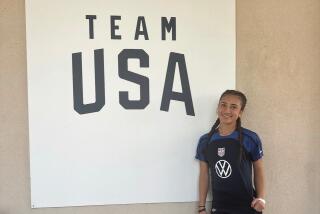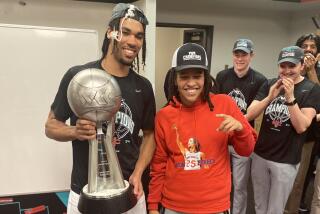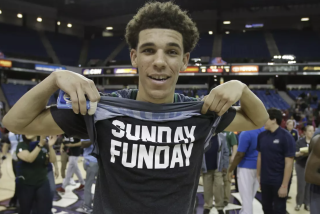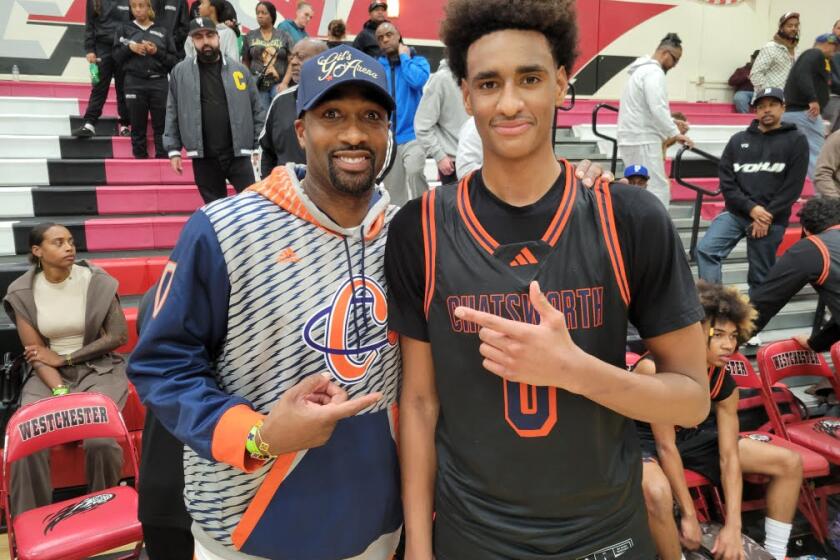Australian Accent : Bright, Joynes Prepare for Careers Down Under While Developing Skills at Area Junior Colleges
Shane Bright of Valley College and Jason Joynes of College of the Canyons share the same dream as many other basketball players: a shot at a professional career.
However, the NBA is not the basketball Shangri-La they seek. Instead, they dream of a career in the NBL, the National Basketball League in Australia.
“Playing in the NBL is my ultimate goal,” said Joynes, a native of Adelaide, South Australia. “Hopefully, playing (in the United States) will help me enough to play in the NBL later.”
Most Australian players use lower-level leagues--such as the Southeast Australian Basketball League (SEABL)--as a steppingstone to the NBL. But increasingly, players such as Joynes and Bright are honing their craft in the United States in preparation for a career in the NBL.
Tonight, freshmen Bright and Joynes will play for their respective teams in the first round of the Southern California junior college regional.
Canyons, the fourth-seeded team in the 32-team regional, will play host to Palomar (12-18). Valley (18-13) will play Oxnard (18-11) at Moorpark College. Both games start at 7 p.m.
To the casual fan, basketball is no different wherever it’s played. But subtle differences between the U. S. game and the version played Down Under challenged Joynes and Bright, a native of Melbourne, Australia.
In Australia, players are governed by a 30-second shot clock as opposed to the 45-second clock in the collegiate game and the NBA’s 24-second clock. Australians must in-bound the ball along the sidelines, never underneath the basket. And there is no five-second rule in Australia. The rule, which applies to the amateur game, requires a player who is closely guarded in his front court to advance toward the basket or pass the ball within five seconds. A held ball is a violation.
The five-second rule had little impact on Joynes, a 6-foot-9, 265-pound bear of a center, because he rarely touches the ball more than 15 feet from the basket.
But the rule wreaked havoc with Bright’s game. He viewed the rule with the same bewilderment that must have gripped the early white Australian settlers upon seeing their first kangaroo.
“I thought it meant that you only had five seconds to hang on to the ball and then you either had to shoot it or pass it to another teammate,” said Bright, chuckling.
“I remember getting the ball in the backcourt, and racing up the court as fast as I could, almost in a panic, and then either passing the ball to someone else or shooting it. The whole time, I’d be counting down the seconds to myself.”
Although Bright, a 5-9 point guard, played two seasons in the SEABL, he maintained his amateur standing because he was not paid. Because of the league’s salary cap, many teams pay only their star players. Others play for free.
Joynes, 22, knew more about the U. S. game than Bright after playing against U. S. collegians when he was a member of various Australian club and national teams. But he quickly discovered the limits of his knowledge.
Despite his bulk, Joynes had been a perimeter shooter in Australia. Playing with his back to the basket on the offensive end of the floor was a new experience to him. It took time to break old habits.
“He shot the ball well facing the basket,” Canyons Coach Lee Smelser said. “That’s a nice dimension for a big man to have. But it was foreign to him to post up to the basket, and once he got the ball, to turn and take it to the hoop as strong as possible.”
Joynes also had to adjust to the more wide-open style of basketball played in the United States.
“It’s more of a full-court game here,” Joynes said. “There are more athletes. In Australia, it tends to be more of a half-court game. That took some getting used to.”
Bright, 19, also noticed differences at his position.
In the SEABL, his coaches encouraged him to “take the ball to the foul line and stick the jumper” after he blew past his defender. If his shot missed, crash the boards, they preached.
That behavior ranks as a federal offense in Valley’s offensive scheme. In the Monarchs’ system, the point guard must retreat and defend against the fast break.
Bright, the Western State Conference assist leader with a 7.3 average, recalled the first time he broke that rule during a game.
“(Valley Coach Jim Stephens) ripped me out of the game and abused the hell out of me,” Bright said. “I couldn’t understand what he was so upset about. In Australia, players can discuss plays with coaches. Here, the coaches demand a lot more respect. You do what they say.”
Joynes, who is averaging 11.6 points and 5.6 rebounds a game, shares Bright’s view. He found himself coming off the bench to play early in the season and sitting back down quickly after making mistakes.
He kept improving, though, and Smelser made him a starter in the Cougars’ 10th game.
“He has worked very hard since he got here to become a better player,” Smelser said. “I couldn’t keep him out of the starting lineup any longer.”
Although Bright and Joynes play in the same conference, neither intended to play at the junior college level in the United States.
Bright had hoped to attend Cal Lutheran and play for Coach Mike Dunlap, who had seen Bright play in the SEABL. After those plans fell through because of financial considerations, Bright considered Pt. Loma Nazarene, another National Assn. of Intercollegiate Athletics school.
Prohibitive costs again nixed his plans, however, and when Dunlap heard that Stephens needed a point guard, he recommended Bright, who enrolled at Valley in late August after talking with Stephens.
At about the same time, Joynes arrived at Canyons.
The former Australian rules football player--he first played basketball at 15--hoped originally to play for Quincy (Ill.) College, an NCAA Division II team, but he did not meet the academic requirements at the school.
Quincy assistant Jeff Dunlap (no relation to Mike), a former assistant at Canyons, then put Joynes in touch with Smelser.
“It was a very pleasant surprise,” said Smelser, who guided Canyons to its second consecutive South Division title this season. “Jason has a great willingness to work to be a better player and the ability to take criticism constructively. Those are traits that a lot of kids don’t have.”
Bright has heard his share of criticism from Stephens, but it has made him a better player, he said.
“He’s taught me some things that I wasn’t aware of before I came here,” Bright said. “I’m a much smarter player now.”
Stephens has taught Bright the importance of when and where to pass the ball to teammates.
“The league I was playing in in Australia was a higher level than the junior colleges here,” Bright said. “So you could pass the ball near a player’s feet and he could pick it up and shoot. But here, I have to put the ball in a particular spot, and that’s improved my passing.”
Stephens expects those instructions to make Bright a better playmaker.
“Shane should be averaging way more than seven assists a game,” Stephens said. “But sometimes he still throws the ball to the wrong guy.”
Bright played under strict orders from Stephens to concentrate only on assists and defense for most of the season. Thus, he would frequently go scoreless in games. Stephens has loosened the reins lately, and Bright has responded with consecutive double-digit scoring efforts to conclude the regular season.
Joynes has made big strides in his game too, according to Smelser.
No one is going to compare his jumping ability with the bounding marsupial mammals of his homeland, but he has become lighter on his feet since the start of the season.
“He had some excess poundage on him when he first came here,” Smelser said. “But he’s lost that and it helps him get up and down the court quicker.”
Both players admit they miss Australia, but neither is complaining about his time in the States.
“I enjoy mucking around (hanging out) with the guys,” said the talkative Bright. “It’s fun being an Australian in America. Everyone wants to hear you speak.”
Joynes knows the feeling.
Affectionately known as Big Brother Jay to teammates, Joynes gets teased constantly about his accent, but he enjoys the attention.
“The guys get on me about it all the time,” Joynes said. “But it’s all in good fun.”
Both Joynes and Bright came to the United States in hopes of earning a scholarship to a four-year school, but it appears that financial constraints will prevent Bright from pursuing that goal next season.
“I’ve only got enough money left to last for another two months,” Bright said. “Coach Stephens has talked about getting me a job, but I don’t think it could pay for all my living expenses. My parents don’t have any more money.
“They’ve given me a great experience. Living in America is something that most people in Australia only dream about. I’ve developed as a human being, as they say. But when the season is over, I’m history.”
Joynes hopes to play well enough for Canyons next season to earn a basketball scholarship. After playing for that school for two seasons, he plans to return to Australia. And he hopes to hook on to the NBL.
“The NBL is big,” Joynes said. “That’s the Australian version of the NBA.”
More to Read
Get our high school sports newsletter
Prep Rally is devoted to the SoCal high school sports experience, bringing you scores, stories and a behind-the-scenes look at what makes prep sports so popular.
You may occasionally receive promotional content from the Los Angeles Times.






